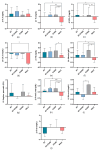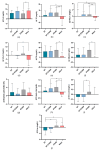Effects of Interrupting Prolonged Sitting with Light-Intensity Physical Activity on Inflammatory and Cardiometabolic Risk Markers in Young Adults with Overweight and Obesity: Secondary Outcome Analyses of the SED-ACT Randomized Controlled Crossover Trial
- PMID: 39199416
- PMCID: PMC11352707
- DOI: 10.3390/biom14081029
Effects of Interrupting Prolonged Sitting with Light-Intensity Physical Activity on Inflammatory and Cardiometabolic Risk Markers in Young Adults with Overweight and Obesity: Secondary Outcome Analyses of the SED-ACT Randomized Controlled Crossover Trial
Abstract
Sedentary behavior (SB) is an essential risk factor for obesity, cardiovascular disease, and type 2 diabetes. Though certain levels of physical activity (PA) may attenuate the detrimental effects of SB, the inflammatory and cardiometabolic responses involved are still not fully understood. The focus of this secondary outcome analysis was to describe how light-intensity PA snacks (LIPASs, alternate sitting and standing, walking or standing continuously) compared with uninterrupted prolonged sitting affect inflammatory and cardiometabolic risk markers. Seventeen young adults with overweight and obesity participated in this study (eight females, 23.4 ± 3.3 years, body mass index (BMI) 29.7 ± 3.8 kg/m2, glycated hemoglobin A1C (HbA1c) 5.4 ± 0.3%, body fat 31.8 ± 8.2%). Participants were randomly assigned to the following conditions which were tested during an 8 h simulated workday: uninterrupted prolonged sitting (SIT), alternate sitting and standing (SIT-STAND, 2.5 h total standing time), continuous standing (STAND), and continuous walking (1.6 km/h; WALK). Each condition also included a standardized non-relativized breakfast and lunch. Venous blood samples were obtained in a fasted state at baseline (T0), 1 h after lunch (T1) and 8 h after baseline (T2). Inflammatory and cardiometabolic risk markers included interleukin-6 (IL-6), c-reactive protein (CRP), total cholesterol (TC), high-density lipoprotein cholesterol (HDL-C), low-density lipoprotein cholesterol (LDL-C), triglycerides (TGs), visceral fat area (VFA), triglyceride-glucose (TyG) index, two lipid ratio measures, TG/HDL-C and TC/HDL-C, albumin, amylase (pancreatic), total protein, uric acid, and urea. We found significant changes in a broad range of certain inflammatory and cardiometabolic risk markers during the intervention phase for IL-6 (p = 0.014), TG (p = 0.012), TC (p = 0.017), HDL-C (p = 0.020), LDL-C (p = 0.021), albumin (p = 0.003), total protein (p = 0.021), and uric acid (p = 0.040) in favor of light-intensity walking compared with uninterrupted prolonged sitting, alternate sitting and standing, and continuous standing. We found no significant changes in CRP (p = 0.529), creatinine (p = 0.199), TyG (p = 0.331), and the lipid ratios TG/HDL-C (p = 0.793) and TC/HDL-C (p = 0.221) in response to the PA snack. During a simulated 8 h work environment replacement and interruption of prolonged sitting with light-intensity walking, significant positive effects on certain inflammatory and cardiometabolic risk markers were found in young adults with overweight and obesity.
Keywords: cardiometabolic risk; light-intensity physical activity snacks; low-grade inflammation; obesity; overweight; sedentary behavior; young adults.
Conflict of interest statement
The authors declare no conflicts of interest.
Figures





References
-
- NCD Risk Factor Collaboration (NCD-RisC) Worldwide Trends in Body-Mass Index, Underweight, Overweight, and Obesity from 1975 to 2016: A Pooled Analysis of 2416 Population-Based Measurement Studies in 128.9 Million Children, Adolescents, and Adults. Lancet. 2017;390:2627–2642. doi: 10.1016/S0140-6736(17)32129-3. - DOI - PMC - PubMed
-
- Phelps N.H., Singleton R.K., Zhou B., Heap R.A., Mishra A., Bennett J.E., Paciorek C.J., Lhoste V.P., Carrillo-Larco R.M., Stevens G.A., et al. Worldwide Trends in Underweight and Obesity from 1990 to 2022: A Pooled Analysis of 3663 Population-Representative Studies with 222 Million Children, Adolescents, and Adults. Lancet. 2024;403:1027–1050. doi: 10.1016/S0140-6736(23)02750-2. - DOI - PMC - PubMed
-
- Lobstein T., Jackson-Leach R., Powis J., Brinsden H., Gray M. World Obesity Atlas 2023. World Obesity Federation; London, UK: 2023.
Publication types
MeSH terms
Substances
LinkOut - more resources
Full Text Sources
Medical
Research Materials
Miscellaneous

